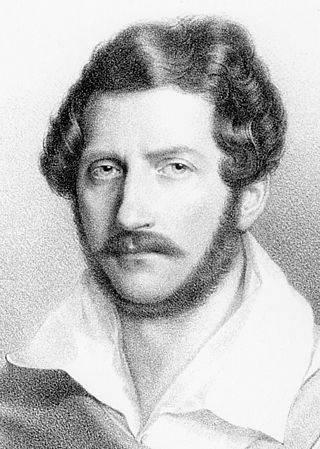Dramma giocoso is a genre of opera common in the mid-18th century. The term is a contraction of dramma giocoso per musica and describes the opera's libretto (text). The genre developed in the Neapolitan opera tradition, mainly through the work of the playwright Carlo Goldoni in Venice. A dramma giocoso characteristically used a grand buffo scene as a dramatic climax at the end of an act. Goldoni's texts always consisted of two long acts with extended finales, followed by a short third act. Composers Baldassare Galuppi, Niccolò Piccinni, and Joseph Haydn set Goldoni's texts to music.

Il campanello or Il campanello di notte is a dramma giocoso, or opera, in one act by Gaetano Donizetti. The composer wrote the Italian libretto after Mathieu-Barthélemy Troin Brunswick and Victor Lhérie's French vaudeville La sonnette de nuit. The premiere took place on 1 June 1836 at the Teatro Nuovo in Naples and was "revived every year over the next decade".

Giuseppe Nicolini was an Italian composer who wrote at least 45 operas. From 1819 onwards, he devoted himself primarily to religious music. He was born and died at Piacenza. The music conservatory of Piacenza is named after him.
Giuseppe Farinelli was an Italian composer active at the end of the 18th century and the beginning of the 19th century who excelled in writing opera buffas. Considered the successor and most successful imitator of Domenico Cimarosa, the greatest of his roughly 60 operas include I riti d'Efeso, La contadina bizzarra and Ginevra degli Almieri. More than 2/3 of his operas were produced between 1800-1810 at the height of his popularity. With the arrival of Gioachino Rossini his operas became less desirable with the public, and by 1817 his operas were no longer performed. His other compositions include 3 piano forte sonatas, 3 oratorios, 11 cantatas, 5 masses, 2 Te Deums, a Stabat Mater, a Salve Regina, a Tantum ergo, numerous motets, and several other sacred works.

Il barbiere di Siviglia, ovvero La precauzione inutile is a comic opera by Giovanni Paisiello to a libretto by Giuseppe Petrosellini, even though his name is not identified on the score's title page.

Elisabetta, regina d'Inghilterra is a dramma per musica or opera in two acts by Gioachino Rossini to a libretto by Giovanni Schmidt, from the play Il paggio di Leicester by Carlo Federici, which itself "was derived from a novel The Recess (1785) by Sophia Lee."
Farsa is a genre of opera, associated with Venice in the late 18th and early 19th centuries. It is also sometimes called farsetta.

Fra i due litiganti il terzo gode is a dramma giocoso in two acts by Giuseppe Sarti. The libretto was after Carlo Goldoni's Le nozze.

Pompeo Magno is an opera in three acts by Francesco Cavalli. It was designated as a dramma per musica. The Italian libretto was by Nicolò Minato.

Oristeo is an opera in a prologue and three acts by Francesco Cavalli. It was designated as a dramma per musica. The Italian libretto was by Giovanni Faustini.

Xerse (Xerxes) is an opera in three acts by Giovanni Bononcini. It was designated as a dramma per musica. The libretto was written by Silvio Stampiglia after that by Nicolò Minato which had been used for the 1654 opera of the same name by Francesco Cavalli. Stampiglia's version was in turn used as the basis for Handel's Serse.

Ciro (Cyrus), also written Il Ciro, is a 1653 Italian drama per musica (opera) in a prologue and three acts with music by Francesco Provenzale and a libretto by Giulio Cesare Sorrentino. The story concerns the Persian king Cyrus the Great. The opera was probably first performed during Carnival of that year at the Teatro San Bartolomeo in Naples, in a production by Giovan Battista Balbi.

Sigismondo is an operatic 'dramma' in two acts by Gioachino Rossini to an Italian libretto by Giuseppe Maria Foppa.

L'equivoco stravagante is an operatic dramma giocoso in two acts by Gioachino Rossini to an Italian libretto by Gaetano Gasbarri. It was Rossini's first attempt at writing a full two-act opera.

Demetrio e Polibio is a two-act operatic dramma serio by Gioachino Rossini to a libretto by Vincenzina Viganò-Mombelli. The opera was orchestrated for flute, oboes, clarinets, basson, horns, trumpets, and strings.

Il Pompeo is a dramma per musica in three acts by composer Alessandro Scarlatti. Written in 1682 when Scarlatti was 22 years old, it was his fourth opera and first dramatic work on a serious and grand subject. The opera uses an Italian language libretto by Nicolò Minato which had previously been used by Francesco Cavalli for his 1666 opera Pompeo Magno. The work premiered at the Teatro di Palazzo Colonna in Rome on 25 January 1683.
Giovanni Domenico Freschi was an Italian composer and Roman Catholic priest. From the age of 22 until his death he worked as a church musician and composer in Vincenza. He was also active as an opera composer from 1671 to 1685.
Antonio Boroni was an Italian composer.










